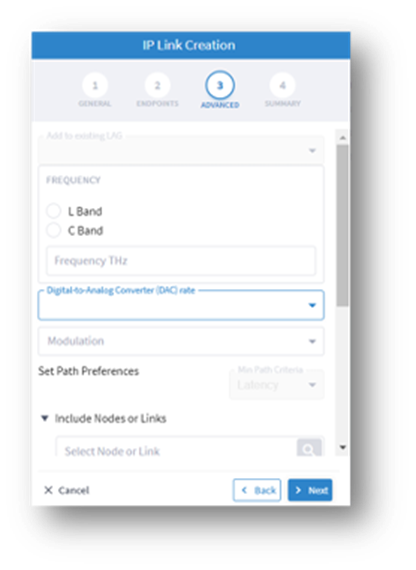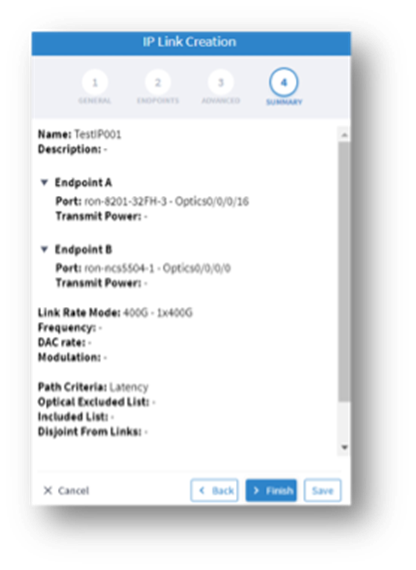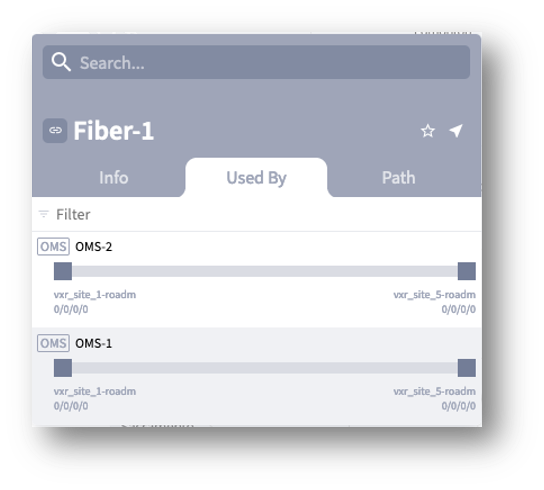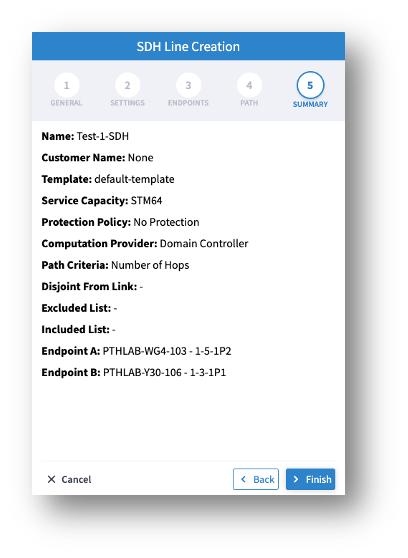Cisco Crosswork Hierarchical Controller 7.0 Release Notes
Available Languages
Bias-Free Language
The documentation set for this product strives to use bias-free language. For the purposes of this documentation set, bias-free is defined as language that does not imply discrimination based on age, disability, gender, racial identity, ethnic identity, sexual orientation, socioeconomic status, and intersectionality. Exceptions may be present in the documentation due to language that is hardcoded in the user interfaces of the product software, language used based on RFP documentation, or language that is used by a referenced third-party product. Learn more about how Cisco is using Inclusive Language.
- US/Canada 800-553-2447
- Worldwide Support Phone Numbers
- All Tools
 Feedback
Feedback
Cisco Crosswork Hierarchical Controller version 7.0 includes new functions and enhancements, as well as bug fixes.
The highlights of these new functions are:
● RON – validation of link between ZR to ROADM
● RON – Bright ZR mode in RON link provisioning
● Events generated on HA status
● Discovery and modelling of L band OMS link
● Use SAML client for single-sign-on
● Provisioning and discovery of SDH line as a new service type
● Delegation of brownfield optical services for service deletion
● L3-VPN and PW/T-LDP provisioning via Crosswork Hierarchical Controller
Validation of Link between ZR to ROADM
The Link Manager application now supports the validation of ZR to ROADM cross-links.
The validation is manually triggered by the user. It arbitrarily selects a wavelength on the ZR port and turns it on and off frequently in a pre-defined pattern (example: 1 second off, 3 seconds on, 4 seconds off, 5 seconds on). Then it measures the Rx power level on this wavelength on the ROADM side (assuming this is supported by the optical controller).
If it finds a match between on/off durations to the flickering in the power levels it declares the link as “validated”. The application provides a graph with Tx power (on/off) on ZR side and Rx power on ROADM side as evidence.

Link Validation Evidence
Advanced Configuration in IP link Provisioning Wizard
This release supports provisioning of Bright ZR pluggable and C/L bands in OMS level. The IP link provisioning wizard is enhanced to support several new parameters.
● Frequency: Select L Band or C Band and specify the Frequency Thz for this link. L-Band introduces a second OMS over the line-side OTS.
● Digital-to-Analog Converter (DAC) rate: The DAC rate is relevant for ZR+ and bright ZR port selection. For 100G, there is no need to change the DAC rate. Supported modes are: 1 X 1 (standard compatible mode) or 1 X 1.25 (Cisco-proprietary mode if both ends of the link are Cisco pluggables). For QAM modulation, only 1 x 1.25 is supported.
● Modulation: 8 QAM, 16 QAM or QPSK (default) to reduce the baud rate for 200G links. The correct modulation is automatically applied: 100G (QPSK), 300G (8 QAM) and 400G (16 QAM)


New Modes in IP Link Provisioning
Events Generated for High Availability Status
New event messages are sent now to the Event table in DB in case of status changes (all events in this table are handled by the Notifications Manager to be sent as emails, Pulsar or SYSLOG messages).
The following events are supported:
● Switchover between nodes, with details on active node and reason.
● Standby node is not responding.
● Witness node is not responding.
● DB sync failed.
Discovery of C/L Bands in OMS Links
The OMS link optical spectrum can be split to two frequency ranges, signified as C and L bands. There can be two OMS links over an OTS link. Such OMS links are now discovered and modelled. When selecting fiber link in the 3D map, the sidebar windows display the two OMS links for selection.

OMS Links with C/L Bands
Use SAML Client for User Authentication
Crosswork Hierarchical Controller uses SAML as a client of the customer’s SAML server for user authentication. Using the SAML client enables single sign-on to multiple platforms using the same authentication server.
The Crosswork Hierarchical Controller SAML client receives the request to open the UI or API call and approaches the SAML server. If the username/IP is already logged in, it gets this approval from the server and lets the user access the system without asking for their credentials again.
Provisioning and Discovery of SDH Line as a New Service Type
A new L1 service type is introduced in HCO. The new service is called SDH line, and it provides the option to create a new service between two SDH ports (OC192 or STM-16) over ODU connection (no support of SDH as transport layer). All service characteristics are the same as OTN line.

SDH Line Service
Delegation of Brownfield Optical Services for Service Deletion
Brownfield OTN line and E-Line services discovered by Crosswork Hierarchical Controller via optical controller can now be managed in Services Manager. Those services can be deleted using Crosswork Hierarchical Controller and modification will be supported in the future.
This is currently supported for the Ciena MCP controller only.
L3-VPN and PW/T-LDP Provisioning via Crosswork Hierarchical Controller
Starting in this release, IP VPN services can be provisioned by a Network Services Orchestrator (NSO) engine, installed as part of the Crosswork Hierarchical Controller solution. Such services are then discovered and modelled by Crosswork Hierarchical Controller for visualization and assurance.
The motivation is to enable customers customizing the service configuration, as is normally required for these services and yet get all the benefits of service visualization and assurance in Crosswork Hierarchical Controller. The value of provisioning service via the NSO engine in Crosswork Hierarchical Controller is the ability to abstract the service to be agnostic to a specific vendor. Such a service can be applied to multiple IP controllers.
The Crosswork Hierarchical Controller-NSO solution will be provided in phases, with R7.0 as the initial phase, with the following characteristics:
● UI for service provisioning and view of service intents is in the native NSO UI. The NSO Service Manager UI can be opened directly from Crosswork Hierarchical Controller Services Manager.
● NBI requests to provision new services, modify or delete services are supported by using the NSO endpoint as an interface.
● Services provisioned are discovered by Crosswork Hierarchical Controller independently from the IP controller, by notification received when the service is successfully provisioned by NSO.
● NSO is installed on the same VM as HCO, with sufficient resources as required by both systems.
To read about the Crosswork Hierarchical Controller-NSO solution, refer to the Crosswork Hierarchical Controller Installation, Administration, and Provisioning Guides.

Crosswork Hierarchical Controller-NSO Solution Architecture
● APP-2126. Losing connection to the SDN controller led to marking some of the optical links as failed with impacted services in the Root Cause Analysis application. This was fixed.
● APP-1921. Previously the Rest API exposed by Link Manager to get all manual links returned an error as a response. This is now fixed.
● APP-2177. When using Time Machine, it is expected that opening 3D explorer on a selected resource via the tooltip would result in the app opened with the resource selected. This had an issue where the app was opened but resource was not selected, and no sidebar was displayed. This issue is fixed.
● APP-2141. The option to hide column in the Inventory application tables didn’t work properly when refreshing the web page. This works now and columns remain hidden after a page refresh.
● SDN-5564. The URL to the REST APIs provided by the Device Manager application is now the correct URL.
● SDN-5858. The SW library for Open SSL v1.1.1l was upgraded to v1.1.1p due to security vulnerabilities.
● SDN-5857. The vulnerability in BusyBox SW v1.35.0 is fixed with an upgrade to v1.35.0.r17.
● SDN-5856. Vulnerability issues in Zlib v1.2.12 have been fixed.
● SDN-3244. For a device with multiple shelves, the device attributes displayed are those of the first shelf. Attributes of other shelves are not displayed.
● FRNT-3831. If wrong credentials were provided for connection to the Network Controller, the discovery will fail but the proper event is not displayed in the Events table on the Adapters tab in Device Manager.
● FRB-57. Currently, only links on the main path of a selected prime object are displayed. The related objects used in the protection path of the prime objects are not displayed (for example, when showing all L3 links over OMS, the displayed L3 links are only those over the main path of the OMS).
● APP-2062. The tooltip map fails to show a manually added cross-link. The site with the cross-link is shown on the map without the pipe between the optical and router layers.
● SDN-5541. The Sidebar for E-Line and OTN services shows the Ports tab as empty. Use the Service Assurance application to properly get all service details.
● FLD-617. An OCH link between two ZR pluggables is displayed in metro view but its wavelength number is not displayed as a label on the link. Such label appears for other OCH links between transponders.
● FLD-603. Filter map by tags does not work properly when the network model contains fiber paths.
● SDN-4684. The satellite view option in 3D map only works when the client machine has an internet connection. The satellite view button is still enabled even when no internet connection is detected.
● SDN-4396. The list of tags in the filter of 3D explorer are currently not displayed in alphabetical order.
● SDN-4221. Service ports that appear under Ports in the sidebar for a selected service may show inconsistent association with a link. A link can sometimes be the service or the PW.
● SDN-5751. The ZR channel and media ports are not displayed in the Ports tab for selected router in the sidebar.
● APP-2337. The filter on the “Type” column in the Failure Impact test result does not work properly. It does not filter the table by the resource type.
System Monitoring
● SDN-4424. When opening the system monitoring page directly after the installation, the information on disk space is empty. The information appears after the configurable monitoring time (a sedo command, covered in the Administration Guide).
● SDN-4016. Usage events for the 3D Explorer application appear with subtype as Frontier.
● APP-1942. SHQL widgets are not displayed in dashboard when results are an empty list.
● SDN-3945. Selecting a site on the map of Sites tab does not work properly in Firefox.
High Availability
● SDN-5722. On rare occasions, a manual switchover between the main and standby nodes fails with a message that the standby cannot be found.
Link Manager
● Application currently does not support adding router-to-router links.
● SDN-5849. If the last cross-link in the table is deleted, then it is wrongly added to the table although it was removed by the user.
Network Inventory
● The Reachability column for devices is displayed in Device Manager or in 3D explorer when selecting the device. This is due to an improper and misleading report on reachability per device when managed by SDN controllers.
Services Manager
● Creation of SDH line service is part of the release content, however it was not tested properly with an Optical Controller. Hence its quality and proper functioning cannot be guaranteed.
● APP-2251. The way to select endpoints in service wizards is to open the model selector and select ports from the relevant table. The filter in Site column does not work properly and the port needs to be located by other parameters.
Performance
● APP-2299. The Refresh button in Performance app does not refreshes the page.
Notifications Manager
● APP-2307. In a system configured to work in high availability mode, events configured to be sent are generated twice by the main and the redundant node.
● SDN-3440. When querying for an inventory item, the children references are missing. Need to use the “downward” command as transformation to object/s children.
● FLD-214. System or user-driven events can be viewed using the SHQL command ‘event’ in SHQL app. The application is currently limited and cannot display more than a few thousand events in a single view. Hence it is recommended to filter the view by event type, sub type, or object guid.
● FLD-382. The sidebar window in the 3D explorer shows a visual view of aggregated links (LAG) and IP logical links. This view is disabled by default. To enable it, please contact your Cisco support team.
● SDN-3867. The View option in SHQL does not allow setting a column name with spaces.
● FRB-201. Certifications imported by a user for local connection purposes (e.g., LDAP) are not kept after a software upgrade. The user needs to manually copy them to the Crosswork Hierarchical Controller repository and run the CA certificate update command (update-ca-certificates).
● SDN-3855. Make sure not to restart Crosswork Hierarchical Controller when daily backup time is close (in minutes). This may cause Crosswork Hierarchical Controller to get stuck in Running mode.
● SDN-5530. Make sure that the size of the imported GeoJSON file with sites info does not exceed 20Mb. For a larger file, it is recommended to split the file into multiple files.
● APP-1848. The new filter in the Network Inventory application allows for filtering the inventory resources by a site or device. The Model Selector allows for selecting other resource type as filters. This should be avoided. Only sites and devices can be used as filters.
● SDN-5713. REST APIs exposed by Link Manager application can be used only by the admin user.
● SDN-5799. It is recommended to use sedo commands to enable or disable an adapter. Doing it from the Device Manager application would work but the wrong status may be shown, and the container will still be running although the adapter will be paused.
● Services Manager. Note that the Packet E-Line wizard works for this service in an optical network, under MPLS-TP tunnel. The menu to create Packet E-Line as T-LDP PW over an IP network is supported in the link referring to the NSO page.
● APP-2271. The SHQL UI app does not support the ‘xin’ command in queries. To use a query with this command, please use the sedo command line.
● SDN-5855. When restarting an application using the sedo command (‘sedo system restart’), it is recommended to disable and then enable all apps, so that the restarted app will be launched immediately.
Use ‘sedo apps disable all’ ; wait 10 seconds, then run ‘sedo apps enable all’.
Crosswork Hierarchical Controller 7.0 comes with a list of network adapters that are updated to work with this version.
Note that not all adapters are generally available. Some are available for specific customers but not as GA, and hence, need BU involvement before use.
Table 1. Adapters
| Vendor |
Protocol/Product |
Availability |
Version |
Content and Use cases |
| Ciena |
MCP |
GA |
6.2/5.1 |
Full inventory and optical topology discovery, service discovery and delegation Provisioning (create and delete) OTN line, SDH line, OCH, E-Line ETH PM |
| Juniper |
Northstar |
GA |
6.1 |
Full inventory and IP topology discovery, RSVP-TE tunnel discovery RSVP-TE tunnel provisioning (create, delete) |
| Cisco |
EPNM |
GA |
7.0/6.1 |
IP discovery of inventory, topology, PM counters. No support of provisioning |
| Cisco |
iOS-XR |
GA |
7.2 |
RON use cases Coverage of inventory and L2 topology discovery |
| Cisco |
CNC |
GA |
4.1/5.0 |
IGP topology, RSVP-TE tunnels, and SR policy discovery RON link provisioning, SR policy provisioning (create, delete) |
| Cisco |
ONC |
GA |
2.1 |
Full inventory and optical topology discovery over NCS1010 RON link provisioning, OCH-NC provisioning Note: The configuration default for “notification” has been changed from NETCONF to CONC_NETCONF. |
Cisco Crosswork Hierarchical Controller release 7.0 can be installed on RedHat Enterprise server 7.6 (Maipo) or CentOS 7.6.1810 (Core), Oracle Linux 8.4, Bare Metal or VM.
Crosswork Hierarchical Controller 6.1 can be upgraded to V7.0.
Server Node
This specification is for active and standby or standalone instances of Cisco Crosswork Hierarchical Controller.
Table 2. Server node specification – small setup (up to 2K NEs)
| Hardware |
Requirement |
| CPU |
10 Cores |
| Memory |
96 GB |
| Storage – for lab |
400GB SSD |
| Storage – for production (only for storage, not including OS needs) |
3 TB disk. These partitions are recommended: ● OS partitions – 500 GB ● Data partition for Crosswork Hierarchical Controller – 2000 GB ● For expansion – 500 GB At least data partitions must use SSD |
| VMs |
1 |
Table 3. Server node specification – mid/large setup (2K NEs and above)
| Hardware |
Requirement |
| CPU |
20 Cores |
| Memory |
192 GB |
| Storage – for production (only for storage, not including OS needs) |
3 TB disk. These partitions are recommended: ● OS partitions – 500 GB ● Data partition for Crosswork Hierarchical Controller – 2000 GB ● For expansion – 500 GB At least data partitions must use SSD |
| VMs |
1 |
Witness Node
The witness node is the third node in ‘three-node-cluster’ high availability solution of Cisco Crosswork Hierarchical Controller.
Table 4. Witness node spec
| Hardware |
Requirement |
| CPU |
8 Cores |
| Memory |
16 GB |
| Storage |
256 GB SSD |
| VMs |
1 |
Chrome version 75 or later is recommended.
Client Machine
The PC or MAC used for the web client with Google Chrome must be equipped with GPU. This is mandatory to run the 3D visualization map in Crosswork Hierarchical Controller.
Build Numbers
<>
In this release, all Crosswork Hierarchical Controller R7.0 documents are relevant and can be used.
This includes:
 Feedback
Feedback